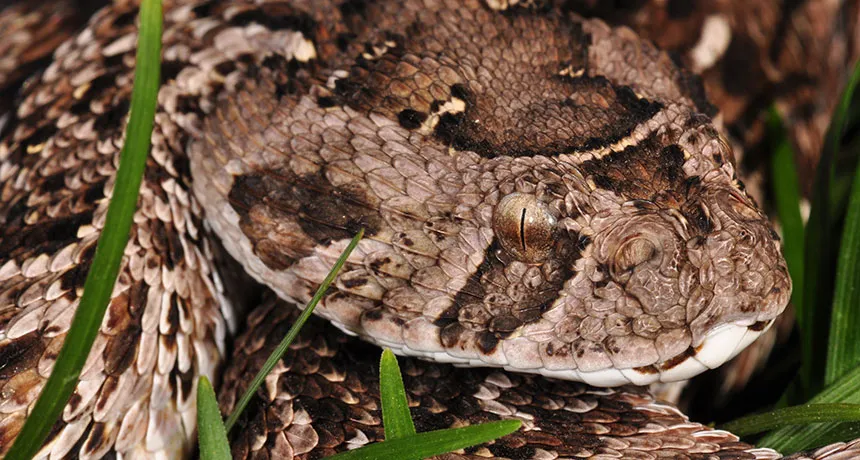
SNIFF TEST Puff adders, with patterns that camouflage them visually, are also so chemically camouflaged that they’re difficult to detect by smell.
Graham Alexander
Puff adders are so difficult to detect by scent that trained snake-finding dogs can walk over a live adder without noticing.
“The puff adders wouldn’t react, and the dogs would be sniffing on the ground — they wouldn’t have a clue that the puff adder was there,” says Ashadee Kay Miller of the University of the Witwatersrand in Johannesburg.
These dog stories came from accidental encounters. But by using snake-scented cloths to mimic meetings with Bitis arietans adders, Miller and her colleagues have tracked what appears to be the first evidence of antidetection chemical camouflage among land vertebrates. Neither dogs nor meerkats picked the scent of puff adder out of an array of odors. Yet the same scent-hunters identified whiffs of other snakes, the scientists report in the Dec. 22 Proceedings of the Royal Society B.
Biologists have described animals mimicking another kind of scent to hunt or hide. But puff adders may have virtually no detectable scent, Miller says.
“If dogs can’t smell puff adders, it’s likely that nothing can,” says Robert S. Voss of the mammalogy department at the American Museum of Natural History in New York City. The challenges created by this kind of chemical camouflage might help explain why mammals have so many fast-evolving genes that code for receptor compounds that detect odors, Voss speculates. “If mammals and their ambush predators are in an olfaction-mediated arms race, then this genetic exuberance makes a lot more sense,” he says.
To test for camouflage by scentlessness, Miller needed dogs that could sniff any scent and then find something that smelled like it. She found none in South Africa at the time, so she and study coauthor Shannon McKay trained four dogs themselves. And using such rewards as Madagascar hissing cockroaches, the researchers also taught scent-matching to five meerkats. “The little guys learned even faster than the dogs,” Miller says.
Both dogs and meerkats proved more than 80 percent accurate in picking a snake-scented cloth out of an array of decoys — as long as the snake wasn’t a puff adder. Neither dogs nor meerkats scored better than random guessing when trying to identify puff adder scent.
If puff adders achieve such stealth by mimicking odors around them, researchers would expect a just-captured wild adder to smell different from its new surroundings. Yet the dogs and meerkats couldn’t distinguish wild adder smell from the scent of its new lab home. However puff adders fake out meerkats and their other wild predators, it’s not by smelling like where they live, Miller says.
One major difference between the puff adders and the easy-to-sniff snakes in the test is that only the former specializes in hunting by ambush. Miller speculates that the ambush lifestyle may favor an excellent ability to hide, chemically or otherwise, for a thick-bodied adder that can’t zip away fast.
But the link between ambush snakes and chemical stealth isn’t universal, notes herpetologist Rick Shine of the University of Sydney in Australia. “The only ambush-forager I’ve worked with, Hoplocephalus bungaroides [broad-headed snake], certainly has a scent that scares the hell out of the lizards it eats,” he says.
Robert Mason of Oregon State University in Corvallis notes that other snake species studied so far, even sea snakes, release pheromones to communicate with others of their species. Mason, a chemical ecologist studying snake-to-snake signals, wonders if puff adders ever turn smelly, at least to others of their kind, during breeding season.
Miller did find that even if puff adders dodge predators by going chemically stealthy, they aren’t always invisible to the nose: Empty skins shed by the adders were far less cryptic than the snakes themselves, carrying dog-smellable traces of the lubricants that helped the snake work itself free.





